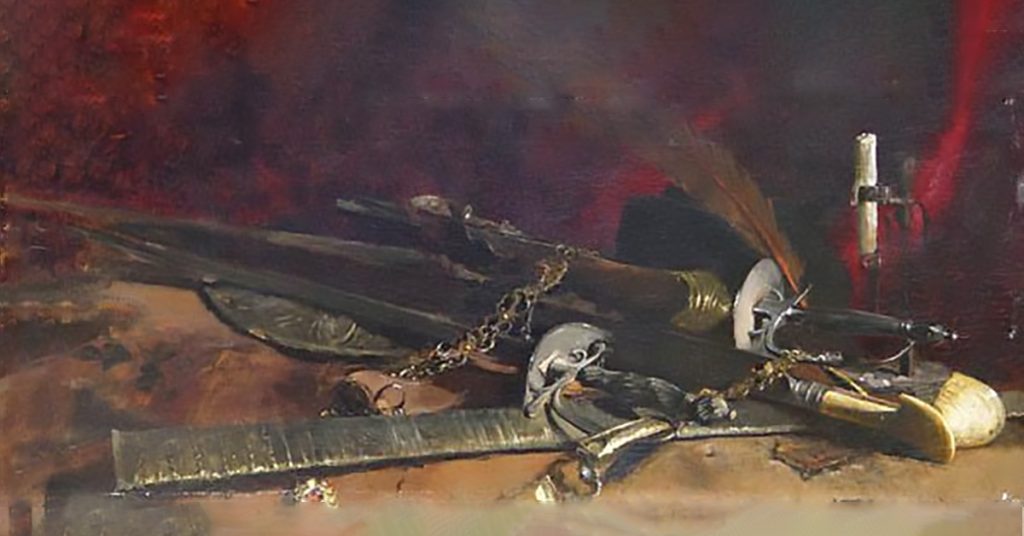Back to Melee Weapon Search
Sword, bastard
Sword, Longsword, Blade, Sidearm, German, Italian, Czech, Slavic, Latin Europe
A bastard sword is a sub - type of the longsword (see Longsword), bastard swords were basically two-handed (or hand and a half) cut-and-thrust swords. They are similar to long swords but slightly shorter (average 45”-47”) usually with stiff, sharply tapering blades of either hexagonal or diamond cross-section. The blade cross-section is shaped a bit like a chisel, designed to hold up to striking other blades and armor plates without breaking, with the stiffness and sharp taper making it specialized for thrusting. Modern tests have revealed that swords of this type also cut surprisingly well against both soft and hard targets.
Oakeshott types XVa and XVII may normally be considered bastard swords. There was also another ‘civilian’ type of bastard sword characterized by a complex hilt including side rings and / or finger rings. These also usually had a flatter, wider blade and were used more for cutting (change to 4/3/5 primary attack type C, no AP bonus). These were less expensive (80 Shilling) and often appeared in town armories for use by the town watch.
 German Bastard sword, 15th Century
German Bastard sword, 15th Century  Bastard Sword, Northern Saxony, 15th Century
Bastard Sword, Northern Saxony, 15th Century  Bastard sword, south German or Swiss, mid-16th Century. This would be a 4/3/5, +2 AP
Bastard sword, south German or Swiss, mid-16th Century. This would be a 4/3/5, +2 AP  A Bastard sword with side ring and finger rings, German late 16th Century. This would be a 4/3/5 weapon.
A Bastard sword with side ring and finger rings, German late 16th Century. This would be a 4/3/5 weapon.  Early 16th Century South German Bastard sword with a side ring and a very broad blade, more of a cutting sword. This of the type which might be used in a civilian context or by a town militia. This would be a 4/2/5, D12 damage weapon.
Early 16th Century South German Bastard sword with a side ring and a very broad blade, more of a cutting sword. This of the type which might be used in a civilian context or by a town militia. This would be a 4/2/5, D12 damage weapon.
| Name | Size | Reach | Speed | Defense | Base Damage | Attack Types | Primary Attack Types | Armor Pierce | Grapple | Hardness | HP |
|---|---|---|---|---|---|---|---|---|---|---|---|
| Sword, bastard | L | 4 | 3 | 4 | 1-10 | SCP | CP | 1 | 0 | 10 | 4 |
 German Bastard sword, 15th Century
German Bastard sword, 15th Century  Bastard Sword, Northern Saxony, 15th Century
Bastard Sword, Northern Saxony, 15th Century  Bastard sword, south German or Swiss, mid-16th Century. This would be a 4/3/5, +2 AP
Bastard sword, south German or Swiss, mid-16th Century. This would be a 4/3/5, +2 AP  A Bastard sword with side ring and finger rings, German late 16th Century. This would be a 4/3/5 weapon.
A Bastard sword with side ring and finger rings, German late 16th Century. This would be a 4/3/5 weapon.  Early 16th Century South German Bastard sword with a side ring and a very broad blade, more of a cutting sword. This of the type which might be used in a civilian context or by a town militia. This would be a 4/2/5, D12 damage weapon.
Early 16th Century South German Bastard sword with a side ring and a very broad blade, more of a cutting sword. This of the type which might be used in a civilian context or by a town militia. This would be a 4/2/5, D12 damage weapon.
